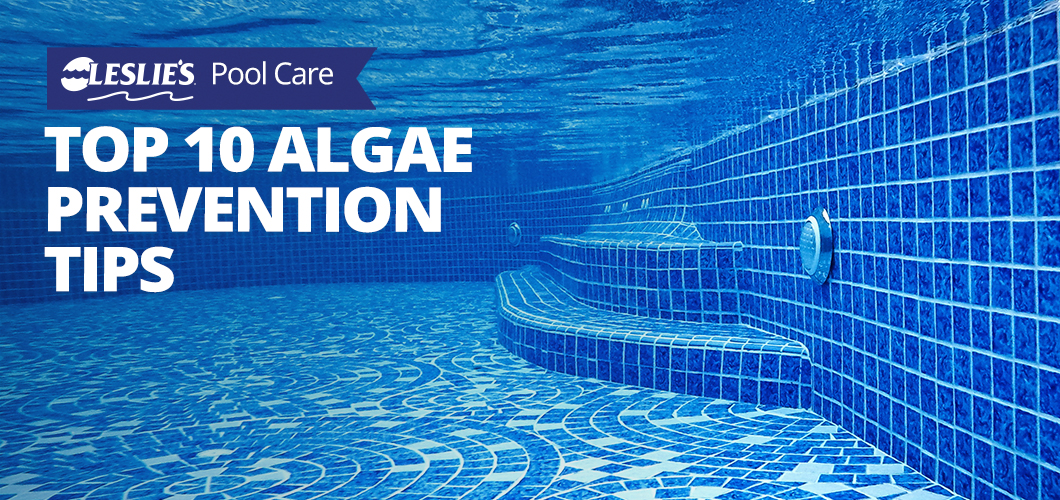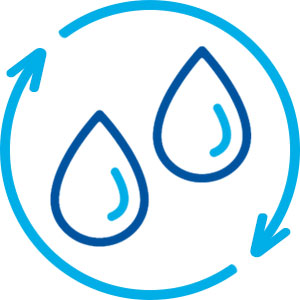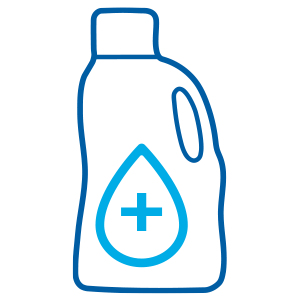
Top 10 Pool Algae Prevention Tips
Nearly every pool owner has had to deal with algae problems at one time or another. Even with a properly-working filtration system, sanitizers at their recommended levels, and a watchful eye, pool algae prevention can still be a challenge.
Algae spores can enter a pool in many ways, but most commonly through wind, rain, dirt, and even on a swimmer’s body or bathing suit. Keeping algae spores out of your pool is impossible. The best you can do is prevent these microscopic spores from turning into unsightly algae blooms that take over the entire pool.
Maintaining clean, algae-free water will help keep your pool and your family happy and healthy. In this post, we'll be going over our best pool algae prevention tips. A few key points include:

Make sure your pool circulation and filtration system is working properly.

Keep your sanitizer in proper range and shock your pool weekly.

Make sure to keep a regular brushing and vacuuming schedule.

Use an algaecide and other appropriate products regularly.
1. Make sure your circulation and filtration system is working properly
Keeping your pool's circulation system in good working condition is one of the most important pool algae prevention steps. To keep your circulation system running properly, you will want to regularly check and clean the skimmer and pump strainer baskets. This will keep the water and sanitizing chemicals flowing evenly throughout your pool.
Along with emptying the skimmer and pump strainer baskets, it's also important to routinely clean or backwash your pool filter. Over time, filters become clogged with dirt and debris and require some simple maintenance. No matter what type of filter you use, it's necessary to clean your cartridge filter or backwash your sand or D.E. filter whenever the pressure gauge reads 8–10 psi higher than normal. Refer to your filter's user manual for more detailed cleaning instructions.
When cleaning or backwashing the filter, Leslie’s recommends using a specialized cleaning aid to help you get the most out of your filter media. Leslie’s Spray & Rinse, Bio-Dex Filter Cleaner, and Leslie's Cartridge Cleaner and Degreaser will help make cleaning a breeze and keep your filter working properly all season.
DIY TIP: During swimming season, we recommend running your pump at least 8 hours per day with a single speed pump, or longer if you have a variable speed pump. During periods of high temps above 80ºF or times of heavy pool usage, increase the run time to 10–12 hours daily. Of course, if you're dealing with algae, run the pump 24 hours per day until it clears up. For more information, check out our blog post about pool pump run time.
2. Always keep sanitizer levels within the ideal range
Algae spores are constantly finding their way into your pool, but the chlorine or other sanitizers in your water usually kill them before they can flourish. However, when sanitizer levels get too low, these spores quickly grow and begin clinging to pool surfaces.
If you use chlorine to keep your pool sanitized, the level should stay between 2.0 and 4.0 parts per million (ppm). To help maintain a safe and effective level of chlorine in your pool, use either an automatic or floating chlorinator for consistent, daily chlorination. This helps prevent chlorine level from dropping below the effective range.
If you are using another type of sanitizer, make sure it is also within the recommended ideal range.
3. Shock the pool weekly
Shock your pool weekly to eliminate any algae spores your daily sanitizer might have missed. Using a chlorine shock, such as Leslie’s Power Powder Plus 73 or Leslie’s Chlor Brite, is a great way to keep your pool clean, maintain sufficient sanitizer levels, and fight off any potential algae problems before they take hold. If using a stabilized chlorine, such as Leslie's 3" Jumbo Tabs, as your primary sanitizer, we recommend using an unstablized chlorine (Leslie's Power Powder Plus 73) or a non-chlorine oxidizer (Leslie's Fresh 'N Clear) to shock your pool.
Using a non-chlorine oxidizer, like Leslie's Fresh 'N Clear, is a popular method for weekly pool treatment. Fresh 'N Clear will help to make your present Free Available Chlorine (FAC) more effective at pool algae prevention. Use Fresh 'N Clear if your FAC level is at 2.0 ppm or higher.
4. Develop and maintain a scheduled brushing routine
Pool walls, floors, and steps are the most common places to find algae in your pool. If left untreated, algae can find its way inside the cracks and crevices in your pool, making it even more difficult to remove. Thoroughly brush the pool walls, steps, and floor at least once a week (or more if necessary) as part of your regular pool algae prevention routine. Pay particular attention to corners and areas with less circulation, which are more likely to harbor algae.
5. Find the right brush for your pool
Using a brush and scrubbing your pool walls is necessary to prevent algae growth, but the wrong kind of brush can do serious damage to your pool surface. If you own a vinyl, fiberglass, acrylic, painted, pebble, or quartz pool, you will want to use a nylon brush. These brushes are softer and won’t tear the vinyl or scratch the surface. For plaster, gunite, or concrete pools, a wire brush provides superior cleaning strength.
BONUS TIP: When using a wire brush, be careful not to apply excessive pressure. Although they're safe to use in plaster, gunite, and concrete pools, too much aggressive brushing can damage pool surfaces.
6. Use a vacuum to remove dirt and debris
Along with brushing and scrubbing, vacuuming your pool is a great way to help prevent algae growth. Brushing the pool walls will dislodge most algae spores that are clinging to the surface, but these spores often settle at the bottom of the pool. Using a vacuum, or one of many automatic pool cleaners, you can eliminate much of the dirt, debris, and contaminants that find their way into your pool.
7. Use an algaecide regularly
Regular use of an algaecide is a great way to keep algae from ever taking hold in your pool. There are many types of algaecides available, designed to help fight different kinds of pool algae. But you don't necessarily have to wait until you have an algae problem to use algaecide. You can also use it when your pool is clean and algae-free. Used in combination with your primary sanitizer, it will stop algae spores from ever becoming a larger problem.
To help stop algae in its tracks, we recommend using Leslie’s Algae Control. It's an easy-to-use, multipurpose algae preventative and treatment that's safe for most types of pools.
8. Eliminate phosphates to prevent algae growth
Algae, like all plants, are living organisms that require food and nourishment to survive. Phosphates, which can enter your pool through dust, leaves, debris, and swimmer waste like sweat and body oils, act as fertilizer for algae. When phosphates are abundant in your pool, it can more easily allow spores to proliferate into full-blown algae blooms. By eliminating phosphates, you can greatly hinder algae growth before it ever begins.
Pool Perfect + PHOSfree is made from 100% natural and safe enzymes, and it is designed to help keep your pool algae-free by getting rid of the phosphates in your pool. If you want the same product with the added benefits of a liquid solar cover, try Leslie's Perfect Weekly. No matter which product you choose, weekly applications directly in the skimmer will help eliminate phosphates and prevent algae growth.
9. Use Pool Magic + PHOSfree when closing your pool for the winter
Even when your pool is closed for the winter season, algae can still take hold of your water. A week before closing your pool, add one bottle of Pool Magic + PHOSfree for every 20,000 gallons of water, directly into your skimmer. Not only will this keep your pool clean and algae-free all winter long, but it will help you have a quick and easy opening when the warm weather returns. Repeat the process when opening your pool to help with the prevention of pool algae. It's an easy way to ensure an algae-free swimming season.
BONUS TIP: Always use caution when cleaning and adding chemicals to your pool. Never mix chemicals before adding them to your pool, and most chemicals require the pump to stay running during application. Always read and follow the instructions provided by the manufacturer to ensure the highest level of safety.
10. Keep a watchful eye on your pool all year long
The four most important steps in owning an algae-free pool are to maintain a cleaning schedule, frequently balance and sanitize the water, circulate/filter the water, and watch for any signs of algae growth. Keeping a routine maintenance schedule will keep nearly all algae spores from taking over your pool as an algae bloom. However, you should always keep a watchful eye on your pool for any algae that may be growing in hard-to-see areas, such as near pool steps or behind ladders. This also means frequent check-ups of your pool, even while it is closed for the winter.
To keep your pool clean, safe, beautiful, and algae-free all year long, just bring a water sample to your local Leslie's for a complete water chemistry analysis. Our free in-store AccuBlue® water test and treatment plan can quickly pinpoint algae-causing issues in your water, including high phosphates and low sanitizer levels. For more information about algae prevention or treatment, call or stop by your local Leslie's!